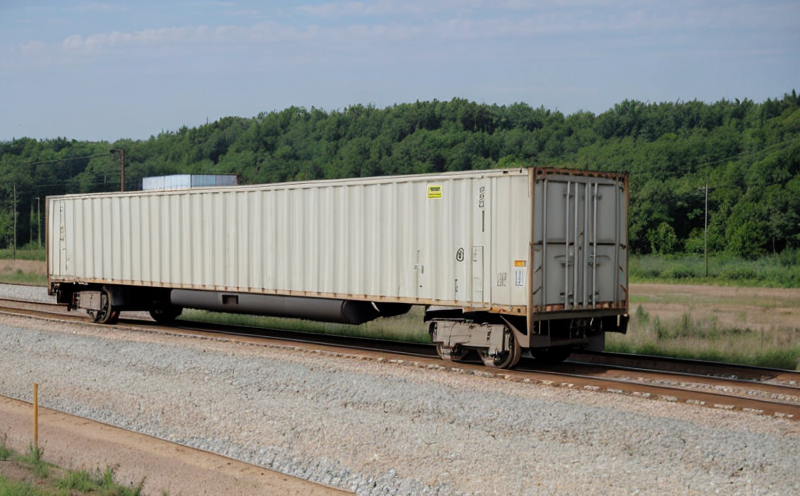EN 13749 Bogie Frame Fatigue Testing for Freight Wagons
The EN 13749 standard is a critical document that specifies the methods and requirements for fatigue testing of bogie frames intended for use in freight wagons. This test ensures that the structural integrity and durability of these components meet the highest safety standards required by railway operations across Europe.
Freight wagons are subjected to continuous stress from the weight of their cargo, the forces exerted during braking, acceleration, and the dynamic loads imposed by various terrains and weather conditions. The bogie frame is a key component that transfers these forces between the wheelset and the wagon body. Therefore, fatigue testing plays an essential role in ensuring that this part can withstand prolonged use without failure.
The bogie frames are subjected to cyclic loading tests to simulate real-world operating conditions. This process involves applying controlled stresses and strains repeatedly until a predetermined number of cycles is reached or evidence of material fatigue appears. The purpose is to identify any potential weaknesses early on, thus preventing failures that could lead to accidents or operational disruptions.
In accordance with EN 13749, the testing procedure typically includes:
- Specimen preparation: Ensuring the sample accurately represents the production batch and meets all necessary pre-test specifications.
- Loading configuration: Applying loads in a manner that reflects actual service conditions as closely as possible.
- Instrumentation setup: Using strain gauges, displacement sensors, and other monitoring devices to record critical parameters during testing.
The results of EN 13749 fatigue tests are analyzed based on the following criteria:
- Visual inspection for surface defects.
- Measurement of residual strains using non-destructive methods like ultrasonic testing or magnetic particle inspection.
- Evaluation of material properties through microstructural examination and hardness testing if necessary.
The outcome provides valuable insights into the fatigue resistance capabilities of the bogie frame, which is crucial for maintaining railway safety standards. Compliance with this standard not only ensures product quality but also supports regulatory requirements imposed by various national and international authorities responsible for rail infrastructure.
At Eurolab, our team of experts meticulously follows all protocols outlined in EN 13749 to deliver accurate and reliable fatigue testing results. Our advanced facilities equipped with state-of-the-art machinery ensure that every test adheres strictly to the specified conditions ensuring consistency and repeatability. This commitment to precision translates into more robust designs capable of enduring harsh environments while minimizing risk factors associated with structural failures.
Understanding how EN 13749 applies directly impacts our approach towards quality assurance within the railway industry, allowing us to contribute significantly toward enhancing overall safety standards for cargo & freight wagon operations worldwide. By adhering rigorously to this standard throughout our testing process, we can provide clients with confidence that their products meet stringent international requirements.
Eurolab Advantages
At Eurolab, we pride ourselves on offering unparalleled expertise and comprehensive services tailored specifically for the railway & transportation sector. Our team comprises highly qualified professionals who possess deep knowledge in various aspects of material testing, including EN 13749 compliance.
- Comprehensive Testing Capabilities: We offer a wide range of tests beyond just EN 13749 bogie frame fatigue testing. Our facility supports multiple standards such as ISO, ASTM, EN, IEC, etc., ensuring comprehensive coverage for all your testing needs.
- State-of-the-Art Equipment: Equipped with cutting-edge technology and instruments, our laboratory guarantees accurate and precise test results every time. This advanced equipment allows us to conduct tests under controlled environments that closely mimic real-world conditions.
- Experienced Staff: Our skilled personnel are continuously updated on the latest developments within their fields through ongoing training programs. They bring extensive experience in performing complex analyses required for meeting stringent regulatory requirements like those stipulated by EN 13749.
- Customer-Centric Approach: We understand that each client has unique needs and expectations; therefore, we strive to provide personalized solutions designed specifically around your objectives. Whether you require assistance with regulatory submissions or simply need reliable testing results, our team is here to support every step of the way.
Choosing Eurolab means partnering with a trusted partner committed to delivering high-quality services consistently. With years of experience behind us and a proven track record of success across numerous projects within the railway & transportation industry, you can rest assured knowing that your testing requirements will be handled efficiently and effectively.
Why Choose This Test
Fatigue testing is an integral part of any comprehensive quality assurance program for freight wagons. Here are several reasons why conducting EN 13749 bogie frame fatigue tests should be a priority:
- Promotes Safety: By identifying potential weaknesses early, this test helps prevent accidents and ensures safe operations on railway networks.
- Enhances Durability: Through rigorous cyclic loading simulations, it evaluates the long-term performance of components under realistic conditions.
- Achieves Regulatory Compliance: Ensuring adherence to international standards like EN 13749 is essential for meeting regulatory requirements and gaining market access in Europe and beyond.
- Supports Innovation: Testing according to this standard encourages continuous improvement by providing feedback on design modifications or material changes that could enhance performance further.
- Reduces Costs: Identifying issues early reduces the likelihood of costly repairs or replacements later down the line, thereby minimizing maintenance expenses over time.
- Bolsters Reputation: Demonstrating commitment to stringent quality control measures enhances brand reputation among customers and stakeholders alike.
In summary, EN 13749 bogie frame fatigue testing offers substantial benefits for both manufacturers and operators in terms of safety, reliability, cost-effectiveness, and regulatory compliance. By incorporating this vital step into your production process or maintenance schedule, you are investing in the future success and longevity of your freight wagon fleet.





